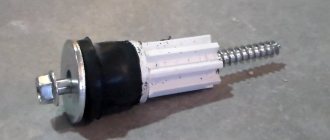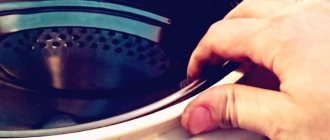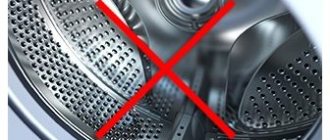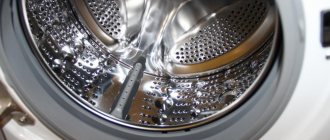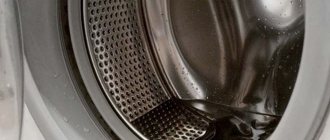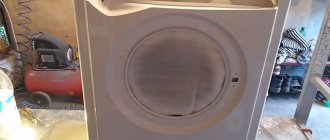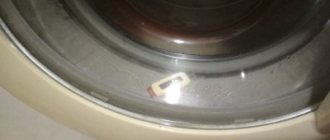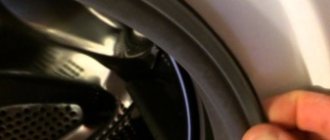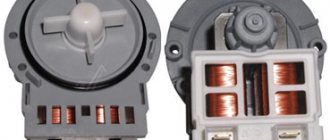If the drum of the washing machine begins to wobble during the spin process or from rocking when it is turned off, then there is no reason for premature worry. The machine tank, together with the drum, is suspended on springs at the top, and at the bottom has supports in the form of shock absorbers.
This allows the entire structure to move in three possible directions. And if the drum dangles during the spinning process, you should not compare this with a catastrophic problem. You probably overloaded your SMA, and it had to respond with chatter.
Additional signs of concern
A breakdown should be suspected if the drum play during spinning begins to be accompanied by certain symptoms:
- the unit rattles, and most of all - when spinning clothes,
- during the spin process, the drum begins to knock on the body part or on the glass loading hatch,
- the washing machine starts jumping or vibrating,
- The drive belt keeps falling off,
- the drum begins to rub against the cuff of the loading door,
- At first glance, the machine works fine, but the rotating drum makes squeaks and other noises,
- oily traces are visible under the unit,
- the machine begins to leak, there are traces of rust on the tank behind the rear panel,
- laundry is stained with oil or rust,
- the drum dangles a lot, then flies off and falls to the bottom,
- the washing machine chews the laundry,
- the drum jams and turns with difficulty, producing a metallic grinding sound,
- During operation, plugs are knocked out, smoke appears from the machine,
- The drum of the device is skewed.
Such a loose element, along with any symptoms, begins to signal a significant breakdown. And even in the case when the machine executes all programs, its operation is not recommended. When the drum of a washing machine dangles, more serious problems can be expected in the near future, including complete disposal of the device.
Spring failure
If the washing machine makes squeaking and knocking noises, and vibrates during the spin cycle, the drum is probably lowered or warped, so it rubs and chews the rubber of the hatch seal. The spring flies off, bends or bursts. The tank is held in place by two or four springs, depending on the SM model. If one of the springs comes off, the balance is disturbed, and intense play occurs during the spin cycle.
If the spring falls off, it is enough to fix it in its original position. But the very fact of its disconnection indicates that a replacement will soon be required.
Causes of breakdowns and the procedure for determining them
A certain percentage of play is built into the washing machine by the manufacturer; this is considered normal. And there is no extraneous noise. But when the conversation turns to a breakdown, you need to act as follows:
- The loading hatch of the washing machine opens, then you should grab the drum with your hands, moving it to the sides without much effort. After this, it must be twisted clockwise and in the opposite direction. If you notice a grinding sound, these are the initial signs of a problem.
- Turn on the washing machine and set the “spin” program to the highest limits. When chatter occurs during rapid rotation, it feels as if the drum has been thrown off its own axis, and loud noises are heard again. Why does this happen? Look for a problem in the bearing or shock absorbers.
- To reliably clarify the failure, it is necessary to inspect the bottom of the machine. In most cases, failure of bearing devices is accompanied by water leakage through moving parts located on an invisible part of the tank. There is a high probability that at the end of the wash a large puddle will appear under the machine. This means that it is high time to replace the seals and bearings.
- When significant knocking noises are heard, but there is no water leakage, the bearings should not be changed - check the shock-absorbing devices. And getting to them is much easier.
The initial stage, which does not involve disassembling the unit, will not help determine anything else. It is possible to finally understand where the problem lies only after penetrating under the body part.
Failure of springs and shock absorbers is usually recognized quickly. They are simply examined thoroughly, shaking them a little. If at least one failed spring is detected, or a broken shock absorber is found, we can assume that the breakdown has been identified and disassembling the tank itself will not be required. And if everything is in order with such elements, then you will have to disassemble the machine further to remove the tank.
Features of repairing top-loading washing machines
Top-loading washing machines are compact in order to save space in the room, many people prefer them. The small size of the unit creates certain difficulties for disassembly and diagnostics. Before you decide to fix the breakdown yourself, you should know the features of repairing washing machines of this design:
- long and difficult disassembly;
- access to nodes is difficult;
- complexity of the device, special equipment is required;
- risk of accidental damage to other parts due to compactness.
How to replace a bearing in a machine
To carry out such repair work, it is necessary to remove the rear housing cover, disconnect the drum from the motor shaft, and sometimes remove the electric motor. Due to the fact that during assembly the bearing is firmly pressed into the mount, it must be knocked out. In a number of models, it is possible to dismantle the crosspiece, and sometimes you have to remove the tank itself.
Particularly difficult are cases where the washing machine has a solid tank made of plastic or composite material. To access the drum, you have to cut it. Instead of the dismantled broken bearing, a new analogue is installed, then the machine is checked for rotation and the rigidity of the drum fastening, and assembly is performed in the reverse order. You can organize a trial run to test the device.
Drain hose
Attaching the drain hose of a washing machine is not complicated, but the work is especially important. Before manipulations, it is necessary to disconnect the machine not only from the power supply, but also from the water supply.
Drain hose
One end of the drain hose is attached to the pump, the other to the sewer, sometimes it is simply lowered into the sink or bathtub. Before disconnecting, you need to drain the remaining water from the machine system by lowering the end of the hose into a low basin or simply onto a rag on the floor. Next, loosen the clamp that holds the hose and remove the hose. We put a new one in its place and tighten the clamp.
We lay the hose inside the machine body so that no kinks are formed, take it outside, and screw it to the sewer. Before assembling the machine, it is important to check that the hose is sealed.
How to replace a shock absorber
This element, like spring hangers, cannot be restored. A specialist will install new ones for you. Temporary measures will not help in such situations. You will have to remove the housing cover, loosen and remove the springs one by one to inspect the fastening points for integrity.
When the tank is freed, you can remove and change the shock absorbers, and hang the tank in its original place. If the old springs have lost their elasticity, they are replaced with new analogues. By the way, when performing work, the master must check the condition of the tank and the supporting bearing cross.
The repair is completed with assembly and testing.
There is a foreign object in the drum
During the washing process you can hear knocking and rumbling noises. Sometimes the cause of this is an object that accidentally ends up in the drum. Often this phenomenon is caused by a break in the shock absorber or spring from the main frame.
During vibration and rocking, the broken element begins to knock on the body and tank quite rhythmically. It may appear that there is an object in the drum. If the element has completely fallen off, the roar will not be very rhythmic, and the drum will sway in a certain direction.
A distinctive sign of suspension problems is the drum swaying at low speeds during washing. Deviation from the axial will immediately catch the eye, and a strong knock will be heard on the body part. It is possible to identify problems with such negative manifestations only through a serious inspection of the device.
Tools needed for repair work
It all depends on the type of damage. If you need to change shock-absorbing elements or springs, then all you need are flat-head and Phillips screwdrivers, an awl, some keys and a repair kit suitable for this model. And if bearings need to be changed, then a wider range of items will be needed:
- hammer with striker made of copper,
- rod or pin made of steel material,
- sealant (cold welding),
- set of screwdrivers and awl,
- open-end wrenches and a set of sockets,
- pliers,
- special lubricant for washing machine parts,
- bearings and seals included.
The shaft is removed from the drum pin with a copper hammer, because this type of striker will not damage the part. A steel rod or other suitable device is needed to knock the bearings out of their seats. The main thing is that such a device must be long and suitable in thickness.
Welding or sealant will be needed when in some model of washing machine the tank turns out to be one-piece. It will have to be sawed along the seam, then the connection will be made. Using an awl, the stuffing box elements are pryed up, pulled out, all fasteners are unscrewed with screwdrivers; keys are needed for the same purpose. Lubricant is applied to shock-absorbing elements and seals.
Damage to the cross shaft
The problems are characterized by play in the drum, which can be swayed by hand without tension. During the spin cycle, intense tapping is observed; water flows through the bearings and oil seal, which also flows from the tank to the bottom of the machine. The laundry shows oil stains, rust and chewing marks.
Probably, the bearings have not been changed for a long time (more than 7 years) and are very worn out. The lubricant has been washed out, which causes dry friction of the shaft, impact on the bearings and oil seal. The bushing of the crosspiece has worn out, and the seating areas where the bearings are located are deformed.
If the cross shaft is severely deformed, the drum will damage the lower area of the tank due to a fall and the bearings will be destroyed. Damaged parts need to be replaced.
5 ways to get a foreign object out of the tank
If you do not get the stuck item out in time, it can pierce the container, cause irreparable damage to the machine, and cause a flood.
- When you hear suspicious sounds, shine a flashlight on the perforated walls. While slowly rotating the tank, determine the source of the noise. If you're lucky, you'll find a bra underwire. Use your fingers or pliers to very carefully remove the item.
- Do you feel resistance when turning the drum? This means that something is jammed between the drum and the casing. Increase the gap near the hatch with a screwdriver and insert a wedge. This will improve access, allow you to find the item and remove it carefully. If it's hard to see, try using a flexible rod to locate the stuck item. When finished, adjust the cuff and move the cylinder into place.
- If you do not find an object in the tank, it is quite possible that it is stuck in the heating element. Depending on the brand of the device, you need to remove the panel (back, front, bottom) and remove the heating element. Check to see if an object is caught on the heating element.
- Did you find anything in the compartment with the water heater? Try looking through the hole in the lower (drain) pipe. To do this, place the machine on its side or at an angle. Slowly rotate the cylinder; when you find an object, remove it.
- If these tips are not suitable for your SM model, the most troublesome option remains - dismantling the drum. This method should also be used to replace bearings, shock absorbers, crosspieces and other parts.
Removing the tank - universal tips
Before you begin dismantling, make sure that your model is equipped with a collapsible tank.
Some modern models from the Bosh, Indesit, Ariston, and Candy brands are equipped with solid containers. Such internals cannot be repaired and are replaced completely, with all components. There are brave souls who cut them and then weld them back together, but this is a rather risky undertaking, and the result is not always positive.
Tanks from the brands LG, Samsung, Electrolux are well understood, and spare parts are easy to purchase. Ready to go? Then let's go!
- Using a screwdriver, unscrew all removable panels and covers, the powder distributor, and disconnect the electrical connectors to provide maximum access to the internal components. Some models are equipped with special latches that simplify matters. In order to get to the tank, you need to remove the counterweights.
- The tank is attached to the body with suspension springs on top and shock absorbers on the bottom. Shock absorbers eliminate vibration during spinning. Even if only one is broken, replace both for proper operation.
- For comfortable replacement of spare parts, unfasten it from the case.
- Remove the plastic casing by unscrewing the bolts or opening the latches (depending on the model), and remove the core. In the drum, on the shaft, there are drive teeth and seats for bearings. The inner bearing sits on the bottom surface.
- Use a screwdriver or awl to remove worn parts. Clean the shaft from rust and check the rod for damage.
- Place the bearings on the seat and check for tight fit. Important! The size of the parts must correspond to the SM model.
- Install the oil seal. It protects the system from water ingress. Lubricate with thick lubricant.
- When changing bearings, pay attention to the crosspiece; it is attached to the cylinder by the shaft. If there are cracks on it, it is better to replace it - unscrew the fastening bolts, remove the old one, and install a new one.
How to remove the tank from a Zanussi SMA
How to replace a bearing in an Ariston or Indesit glued tank
These simple rules will help you troubleshoot problems at home. The machine will last longer, and you will save on calling a specialist.
How causes are identified in machines from various companies
Minor drum chatter in Ariston, Kandy, Bosch, LG or Samsung washing machines is provided for by the manufacturer from the very beginning. Backlash is necessary for the normal functioning of the device. But such rocking of the drum does not cause the formation of extraneous knocks during the washing process. But when they are heard during the spin cycle, it is recommended to take a number of actions:
- open the loading door, grab the drum with your hands, and twist it. If you hear a grinding noise, look for the problem.
- Indesit starts with an empty drum at maximum. If during rotation there is a feeling of large vibrations accompanied by noise, then it is necessary to inspect the bearings or shock-absorbing devices,
- pay attention to water that may leak from the machine,
- If you hear a grinding noise but cannot find a leak, replace the shock absorbers.
Verdict
If you are not sure or difficulties arise during the process of replacing parts, it is better to leave your idea until the technician arrives. Incorrect manipulations and incorrect connection of the device to the system can lead to breakdown of vital parts for the equipment. It is better to entrust complex repairs to specialists
.
Washing machines often break down. They can be serious and not very serious. You can ignore minor problems for the time being, since they will not lead to major troubles. But serious problems require immediate attention, because if you delay repairs, the washing machine may completely fail.
If you notice that the drum has started to loosen, wait until the wash is finished and do not start the unit until the problem has been fixed. It is recommended to immediately diagnose the machine: this can be done by contacting a service center, or you can solve the problem yourself.
Advice from the experts
If there is a problem with a bearing or shock-absorbing device, then all elements should be replaced, because a failed part will soon lead to a chain of problems from its analogues. And when you have disassembled the washing device, immediately change the seals, which also have operating limitations and wear out quite quickly.
Remember that machines from different manufacturers differ in their design and are disassembled in different ways. This feature should also be taken into account when undertaking repair work on your own.
Disassembling the unit tank and removing the bearings must be done correctly. There are washing machines in which it is possible to get to the shock absorber through the top of the machine or through its bottom. This convenient feature helps save time during repairs - you don’t have to remove the panels.
Cleaning
Periodic cleaning of the drum will avoid premature breakdown of all components of the washing machine.
Perform this procedure as follows:
- Five sachets of citric acid are poured into the washing powder compartment.
- Start the wash cycle at the highest temperature.
- After its completion, remove the remaining stains with a fluffy brush.
It is recommended to carry out such cleaning for preventive purposes at least once every six months. Instead of citric acid, you can use 9% vinegar. White is added to disinfect the device. This article will tell you about cleaning the washing machine drum from scale.

